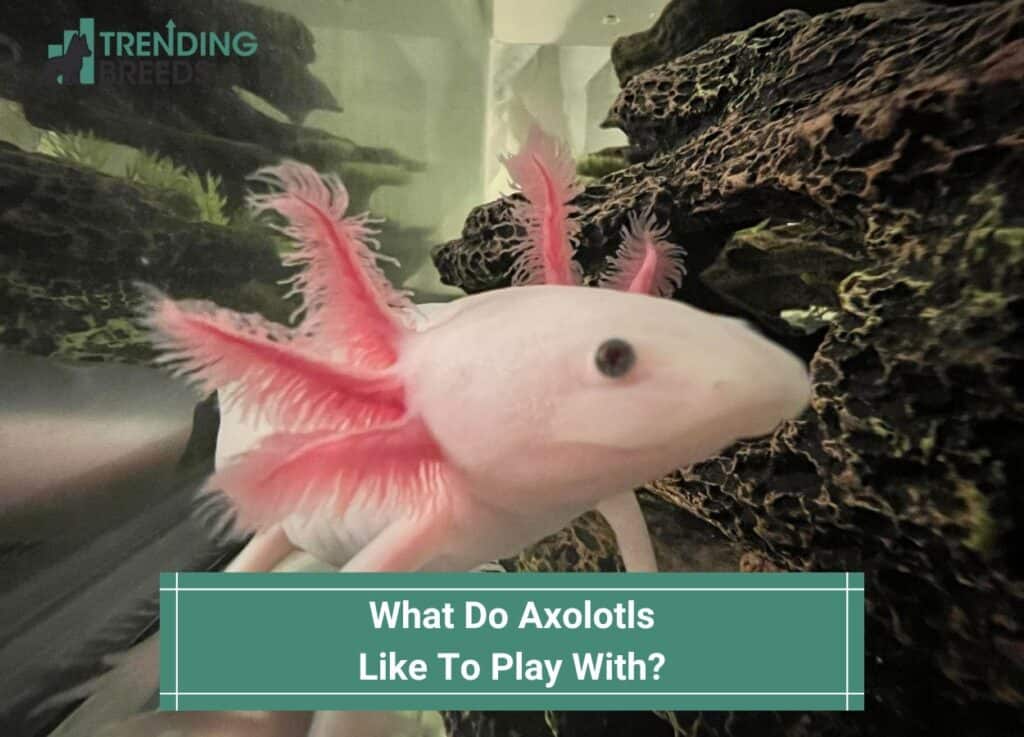
Are you curious about whether you know what Axolotls like to play with?
If you have one or more pet Axolotls at home, you may have observed them exploring the bottom of their tanks or seeking shelter among plants.
This playful behavior is typical for Axolotls, allowing them to interact with their surroundings.
Although Axolotls are typically solitary and tend to remain calm, they still enjoy engaging with their environment.
While they may not specifically play with toys, there are several ways to enhance your Axolotl’s tank and provide them with a more stimulating environment.
Read on to learn more.
Before you scroll further down this guide, check out these other animal-related articles: Can Dogs Play With Catnip Toys? and Do Rats Play Dead?.
Table of Contents
Recreational Activities and Objects For Axolotls

Hiding Places
Axolotls appreciate having hiding spots in their tank. PVC pipes, ceramic or resin caves, or other suitable structures are best for them to retreat into.
Live Prey
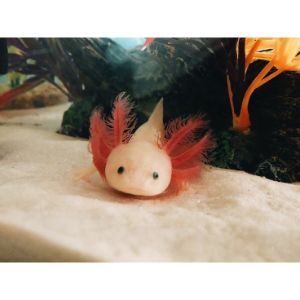
Axolotls are opportunistic predators who enjoy hunting and consuming prey.
Feeding them live brine shrimp, bloodworms, or small fish can engage their instincts and provide mental and physical stimulation.
Gentle Current
Axolotls enjoy swimming against a mild current created by a properly adjusted filter or aquarium pump.
That mimics their natural habitat and allows them to exercise and play by swimming against the flow.
Natural Decor

Adding live or artificial aquatic plants, rocks, and driftwood to the tank creates a more engaging and aesthetically pleasing environment.
These features provide places to explore, hide, and interact with.
Floating Objects
Axolotls may be curious about floating objects in their tank.
Placing floating plants, cork bark pieces, or other buoyant items can give them things to investigate and interact with.
Target Feeding

Using a target feeding method can offer mental stimulation.
By associating a specific target (e.g., a small stick or container lid) with food, you can encourage your Axolotl to swim and “follow” the target during feeding sessions.
Hand-Feeding
Hand-feeding can create a bond between you and your Axolotl.
Offering food directly with long, smooth tweezers or a feeding stick provides a more interactive feeding experience and helps with recognition.
Tank Rearrangement

Occasionally, rearranging tank decor or adding new elements can stimulate curiosity and encourage exploration.
Remember to ensure the objects and decorations in their tank are safe and free from any potential harm, as axolotls have delicate skin.
Monitoring their behavior and adjusting the environment based on their preferences is crucial to providing them with a stimulating and enjoyable habitat.
Do They Like to Play?

Axolotls are not playful in the same way as mammals or some other pets.
They do not engage in traditional play behaviors and may not show interest in toys or specific activities.
However, Axolotls can demonstrate curiosity and exploratory behaviors within their tank.
You may notice your pet Axolotl nudging or pushing plants and rocks, digging the substrate, or tossing their food around.
Some Axolotls may follow your finger along the glass or show curiosity when observing you.
While these actions may not align with traditional notions of play, they can be seen as playful behaviors for Axolotls as they interact with their environment.
Do They Like Playing With Toys?
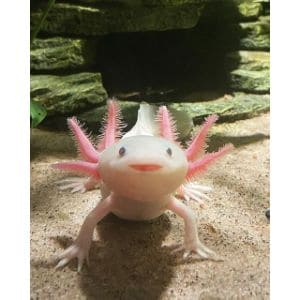
Axolotls do not typically enjoy playing with toys or objects in the same way as other pets, such as dogs or cats.
They have a more calm, relaxed, and solitary nature, and their needs differ from those of traditional, playful pets.
Axolotls find contentment in their natural surroundings rather than seeking interactive play.
They prefer to hide under rocks, swim gracefully, rest among plants, and observe their environment.
While specific toys are unnecessary, providing them with a well-designed tank environment that mimics their natural habitat is essential.
That includes suitable hiding places and aquatic plants, contributing to their well-being and happiness.
Can You Play With Your Axolotls?

While you can interact with your Axolotl, it’s essential to approach it in a way that respects its delicate nature.
Physical interaction such as touching, petting, or holding is unsuitable for Axolotls as they are incredibly fragile and sensitive.
They do not enjoy being hand-held in the same way as other pets.
Instead, you can observe and appreciate their natural behaviors and movements in the tank.
You can provide them with a well-designed environment with hiding places, plants, and suitable tank conditions to ensure their comfort and well-being.
That allows them to engage with their surroundings on their terms.
It’s crucial to prioritize the safety and well-being of your Axolotl when considering any form of interaction.
Playing With Axolotls
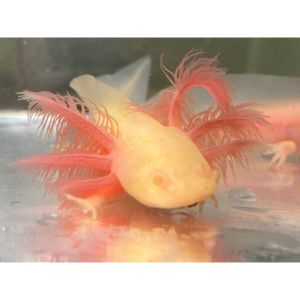
When it comes to interacting with your Axolotl, there are some gentle ways to engage with them:
Feeding Time
Take advantage of feeding time to create a playful experience.
Use feeding tongs to gently wiggle bloodworms or brine shrimp, mimicking the movement of their natural prey.
That can stimulate their hunting instinct and make the feeding process more engaging.
Tank Environment
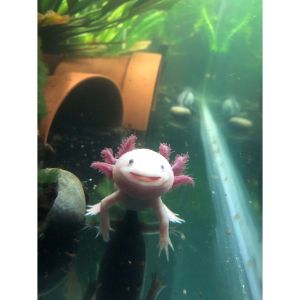
Create a stimulating tank environment for your Axolotl. Include different types of plants, rocks, and hiding spots for them to explore.
Watching them interact with their surroundings can be a source of enjoyment and entertainment.
Touching and Trust
While Axolotls generally don’t enjoy being handled, you can still establish a level of touch-based interaction.
Place your palm in the water and wait for the Axolotl to approach and contact you. Let them initiate the contact and avoid being pushy.
They might allow you to gently stroke their tail or belly if they become comfortable with your presence.
It’s essential to be cautious and not overdo it, as excessive handling can stress them.
It’s rare, but when Axolotls are incredibly comfortable, they may even lay eggs on your hand.
Avoid Abrupt Movements
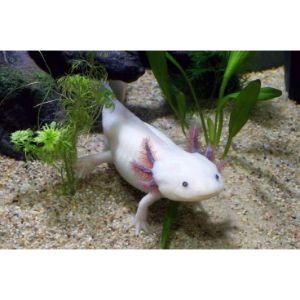
Refrain from sudden or rapid movements in or around Axolotl’s tank.
These actions can startle them and make them feel threatened. Instead, move slowly and carefully to maintain a calm environment.
Finger Movement
You can gently move your finger along the glass wall of the tank and observe if the Axolotl follows it.
Some Axolotls, especially those recognizing their owner, may be interested and engage in this activity. It can be an interactive way to interact with your pet Axolotl.
Remember, every Axolotl is unique, and their comfort levels may vary.
Please pay attention to their body language and reactions to ensure you’re providing a positive and stress-free experience.
How Do You Keep an Axolotl Entertained?
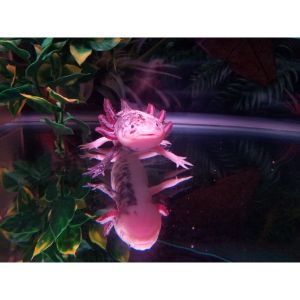
To keep your Axolotl entertained and stimulated, here are some strategies you can implement:
Create a Well-Planted Tank
Ensure your Axolotl’s tank has aquatic plants, rocks, and hiding spots. That provides them with a visually exciting environment to explore and interact with.
Mimic Gentle Currents

Use air stones and a low-flow filter to create a gentle current in the tank. Axolotls may enjoy swimming against the currents and investigating the movements they produce.
Diverse Diet and Target Feeding
Offer your Axolotl a varied diet and occasional treats. Allow them to chase and hunt their prey, which can mentally stimulate them.
You can create games like target feeding using a stick or feeding tong.
Guide their food towards the target and let them follow and catch it, stimulating their natural hunting instincts.
Tank Environment Novelty

Axolotls often rearrange their hiding spots and decor despite having a well-organized tank.
That can keep the tank environment fresh and introduce novelty, preventing boredom.
Natural Daylight Exposure
Axolotls are diurnal creatures, so exposure to natural daylight can enhance their activity level.
Place their tank in an area with natural lighting, but ensure it is not exposed to direct sunlight, as this can increase the water temperature to unacceptable levels for the Axolotl.
By incorporating these strategies, you can provide your Axolotl with mental and physical stimulation, making their environment more engaging and enjoyable.
Do Axolotls Need Friends to Play With?

Axolotls are solitary creatures and do not have a strong social drive. They do not require a friend or companion to play with.
Introducing multiple Axolotls in the same tank can lead to disputes, stress, and potential harm.
Axolotls perceive each other as potential competitors, especially when it is not the breeding season.
Keeping multiple Axolotls together can result in aggression and territorial behavior.
It is best to provide each Axolotl with its separate tank to ensure their well-being and minimize potential conflicts.
While Axolotls may not engage in social play, they can still provide entertainment and enjoyment through their natural behaviors and interactions with their environment.
Focus on creating a stimulating and enriched tank environment for your Axolotl to explore and thrive in.
Do They Get Bored?
Axolotls do not experience boredom in the same way that humans or other animals might.
They do not possess the same emotions and cognitive abilities as humans.
While they may show signs of behavioral monotony if their environment lacks stimulation, it is inaccurate to say they are experiencing boredom.
Their instincts and biological needs primarily drive axolotls.
As long as their tank environment meets their temperature, water quality, hiding places, and suitable prey requirements, they can live contentedly without experiencing boredom.
Providing them with a well-designed tank and proper care will ensure their overall well-being and keep them engaged in their natural behaviors.
FAQs About Axolotls

How do I keep my Axolotl entertained?
While axolotls don’t require extensive entertainment like other pets, there are a few things you can do to provide stimulation:
- Create an enriched tank environment with plants, rocks, and hiding spots for exploration.
- Mimic gentle currents with air stones or a low-flow filter encourage swimming and investigation.
- Offer a diverse diet and occasional treats, allowing them to engage their hunting instincts.
- Occasionally rearrange the tank decor to introduce novelty and keep them curious.
Can you play with a pet axolotl?
While axolotls may not engage in play in the same way as dogs or cats, some interaction is enjoyable with certain precautions:
- Avoid direct physical contact or handling, as axolotls are delicate and sensitive to touch.
- During feeding time, you can engage them by gently wiggling their food, mimicking prey movement to stimulate their hunting instincts.
- Observing their natural behaviors and providing an enriched tank environment can be enjoyable for both the owner and the Axolotl.
What do axolotls love the most?
Axolotls have specific preferences and behaviors that can bring them joy and contentment. Here are some things they may love:
Suitable hiding places
Axolotls appreciate having hiding spots in their tank, such as PVC pipes, caves, or dense vegetation. These provide them with a sense of security and privacy.
A well-designed tank environment
Axolotls enjoy exploring their surroundings, so a tank with aquatic plants, rocks, and driftwood can provide them with opportunities for investigation and interaction.
Live prey
Axolotls are opportunistic predators and enjoy hunting live game.
Feeding them live brine shrimp, bloodworms, or small fish can engage their instincts and provide mental and physical stimulation.
Gentle water flow
Axolotls enjoy swimming against a mild current created by a properly adjusted filter or aquarium pump.
That mimics their natural habitat and allows them to exercise and play by swimming against the flow.
What will make my Axolotl happy?
Creating a suitable environment and providing proper care can contribute to the happiness and well-being of your Axolotl. Here are some key factors to consider:
Optimal tank conditions
Maintain appropriate water parameters, including temperature (around 60-68°F or 15-20°C), pH levels, and water quality. Axolotls thrive in clean, well-maintained tanks.
Adequate space
Provide enough space in the tank for your Axolotl to swim and explore. A tank size of at least 20 gallons per Axolotl is best.
Enriched tank environment
Include aquatic plants, rocks, and hiding spots to create a stimulating and natural-looking habitat. That allows your Axolotl to exhibit natural behaviors and feel secure.
Suitable lighting
Axolotls prefer dim lighting, so avoid bright or direct sunlight. Use low-intensity aquarium lighting or provide natural ambient light in the room.
Appropriate diet
Offer a varied diet of high-quality, species-specific food. That can include live or frozen foods like bloodworms, brine shrimp, and pellets formulated for axolotls.
Avoid stress and excessive handling
Axolotls are sensitive creatures, so minimize disturbances and avoid handling them excessively. Respect their need for privacy and a calm environment.
What do Axolotls need in their tank?
To provide a suitable habitat for your Axolotl, consider the following:
Tank size
Axolotls require ample space to swim and explore. A tank size of at least 20 gallons per Axolotl is best, but larger tanks are preferable.
Water parameters
Maintain water temperature between 60-68°F (15-20°C) and pH levels around 7.0-7.5.
Use a reliable thermometer and water test kit to monitor and adjust these parameters.
Filtration
Use a gentle filtration system to maintain water quality and circulation.
Axolotls are sensitive to strong currents, so choose a filter with an adjustable flow or create baffles to reduce water movement.
Substrate
To avoid potential ingestion issues, provide a soft substrate, such as sand or fine gravel. Avoid using small rocks or sharp materials that could harm the Axolotl.
Hiding places
Include various hiding spots like rocks, caves, and aquatic plants. Axolotls appreciate places to retreat and feel secure.
Lighting
Axolotls prefer dim lighting, providing low-intensity aquarium lighting or natural ambient light. Avoid bright or direct sunlight, as it can raise the water temperature.
Water quality
Regularly monitor and maintain good water quality by performing partial water changes and using a water conditioner to remove chlorine and other harmful substances.
What Do Axolotls Like To Play With?

Creating a suitable and enriching tank environment is essential for the well-being of Axolotls.
You can provide these fascinating creatures with a comfortable and stimulating habitat by meeting their specific needs.
Remember to monitor water quality and temperature regularly to ensure a healthy environment for your axolotls.
Following these guidelines and providing a well-designed tank can help promote your Axolotl pets’ happiness and overall thriving.
If you find this guide, “What Do Axolotls Like To Play With,” informative and helpful, you can check out these other animal-related articles from our team:
You can learn more about axolotls by watching “Axolotl Facts: the PETER PAN Salamander 🦎 Animal Fact Files” down below:


![Can Dogs Play With Catnip Toys? Is It Safe? [+ Alternatives] (2024) A German shepherd and cat sitting together indoors with a small cat toy between them.](https://www.trendingbreeds.com/wp-content/uploads/2022/02/GSD-and-cat-with-small-toy-150x150.jpg)

